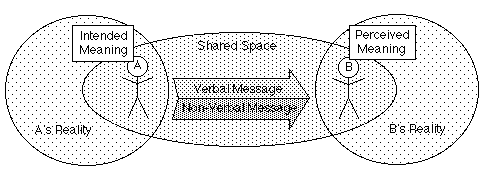
9 Jan 2008 @ 22:45, by Flemming Funch
Somebody asked for permission to use my old graphic here in a training course for field epidemiologists in Kazakhstan. Which is kind of funny. And I don't remember if I ever posted it here, so why not. Below is the article that goes with it. Although I thought it was kind of well hidden on the net, I do get these kinds of requests from time to time. ... And now that I notice it, this is actually the #1 "I feel lucky" entry for "Communication Model" in Google, which I can't complain about.
There is always a sender and a receiver in communication. At least there is an intended receiver. In the diagram above A is the sender, B is the receiver.
A and B have different personal realities. They each have their own world formed by their experiences, their perceptions, their ideas, etc. They will perceive, experience, and interpret things differently. The same event will always be perceived a little different by each of two people.
For the consideration to communicate to appear at all there must be some kind of shared space. The participants must have some kind of concept of each other's location and of a possible channel of communication existing between them. They must agree sufficiently on these to agree that communication is taking place.
The sender will have some kind of meaning she wishes to convey to the receiver. It might not be conscious knowledge, it might be a sub-conscious wish for communication. What is desired to be communicated would be some kind of idea, perception, feeling, or datum. It will be a part of her reality that she wishes to send to somebody else.
Something will be transmitted across a distance in the shared space. We can regard it as an object, a particle, or as a wave, or flow. It might be sound vibrations, rays of light, words, pieces of paper, cannon balls, body language, telepathy, or whatever.
Between humans there will be several layers of the message being sent. There will often be a verbal portion, something that is being expressed in language, spoken or written. And there is also a non-verbal portion, covering everything else, most notably body language. Sometimes the verbal and non-verbal messages don't agree with each other, they are incongruent. If they do agree we say that they are congruent.
Based on what the receiver perceives, and based on her interpretation of the verbal and non-verbal input, she will form a concept in her reality of what the meaning of the message is. It will mean something to her. It might or might not be what was intended by the sender. In successful communication the perceived message will approximate the intended message to the sender's satisfaction. However, the sender will only know that if she receives a message back that is congruent with what she had in mind.
One can never take for granted that the receiver has the same reality as the sender. One can never take for granted that the receiver will interpret the message the same way as the sender intended it.
Communication is not an absolute finite thing. Particularly, communication with language is always vague and misleading to some extent.
If A says a word, like for example "trust", she has a certain meaning attached to it in her reality. She has had certain experiences with the subject matter, she has made certain conclusions about it, and she has certain perceptual filters concerning it. The meaning of the word is all the stuff it is associated with in her reality. However, because words also have nice, finite dictionary definitions it might appear as if the word is something very precise.
What travels across the communication channel is NOT all the associations that A made about the word, and NOT the intentions she had with using it. What crosses the distance is symbols.
When B hears the word or sentence she will interpret it based on her experiences, perceptions, and opinions. She might supplement the verbal information with non-verbal information such as body language. She might also hallucinate what it is supposed to mean. In one way or another she arrives at the meaning she assigns to it.
There is wide agreement, at least within a particular culture, on what common physical objects are. When you say "car" or "refrigerator" most people will have an understanding very close to yours. But if you say words for abstract qualities, like "trust", "love", "right", "wrong", and so forth, then there is wide variance on what people mean.
To have effective communication one needs to take all the factors into consideration. The different realities, the space the communication takes place in, verbal as well as non-verbal messages, the intended meaning versus the perceived meaning.
|
|
